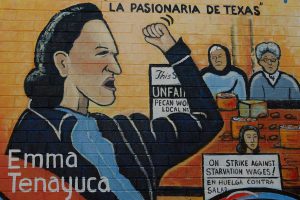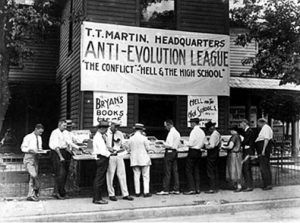She gazes faintly from behind the deputy sheriff as she watches complete strangers determine her fate, listening to the prosecution rest its case against her. The courtroom is crowded, and everyone is anxious to know the verdict. Is she guilty or innocent? The trial is receiving attention from all over Massachusetts. Headlines have been reporting what is known of the wealthy Andrew Borden’s death, labeling him a “vulnerable citizen,” calling his death a “shocking crime,” even going as far as to speculate that the daughter of Mr. Borden, who first discovered his murder, was actually responsible for it. When did this become her life? A woman with excellent social background, a Sunday school teacher, a member of the Women’s Christian Temperance Union, and member of the board of the Fall River hospital, is now a suspect of a gruesome murder. Social background doesn’t matter, truth doesn’t matter; truth is out of her hands, out of her control. All she can do at this moment is listen to the allegations against her and worry for her life.
It was August 4, 1892 at 11 A.M when thirty-three year old Lizzie Borden let out a scream. “Maggie, come down! Come down quick; father’s dead; somebody came in and killed him.” Upon entering the house, the Borden maid Bridget “Maggie” Sullivan saw the lifeless body of the wealthy Andrew Borden with his face hacked away on a love seat, and his wife Abby Dufree Gray laying upstairs, hacked and lifeless as well. Police were notified, and immediately upon arriving at the Borden home, they began searching. Blood trails couldn’t be located, a weapon couldn’t be found, and forced entry wasn’t possible because police reported the house being orderly. It was determined that the couple was murdered fifteen minutes apart, but with the lack of further evidence, the murder became an immediate mystery.1
With a lack of evidence and no suspects, Police Chief Marshal Hillard questioned all those present in the Borden home at the time of the murders. Bridget reported that she was cleaning the windows, and Lizzie said she was putting shams on the pillows. A guest who wasn’t present at the time of the murders, John Morse, uncle to Lizzie Borden, was later questioned, along with Lizzie’s sister Emma, who was out of town during the murders. It was reported by Lizzie that she heard a man speaking with her father earlier that morning, saying, “I would like to have that place; I would like to have that store,” after which Mr. Borden asked him to leave. This inquisition moved to the courts on August 9, 1892, and Bridget and Lizzie were again questioned. When asked where Lizzie was during the fifteen minutes apart from the two murders, she told Hillard that she was in the barn looking for iron bars; however, upon investigation, no footprints were found in the barn, out of the barn, or near the barn. Lizzie failed to provide solid accounts, and police found it difficult to believe that Lizzie had no idea of her stepmother’s whereabouts. A statement from a local druggist, Eli Bence, claimed that Lizzie had earlier sought to purchase a lethal item, prussic acid. The idea of an intruder was once again revisited, but the evidence never once pointed to an intruder. On August 11, 1892, Lizzie Andrew Borden was arrested for the murders of Andrew Borden and Abby Dufree Gray.2
The preliminary hearing for Lizzie began on August 22, 1892, in Taunton, Massachusetts, and Lizzie entered a plea of not guilty. Judge Josiah Blaisdell pronounced the accused as “Probably guilty,” and made the decision to allow Lizzie to face a grand jury. The jury met for the first time in November of 1892, consisting of twelve white and wealthy men.3

Accounts of Lizzie and her behavior prior to the murders and after were reviewed by the jury along with new information from family friend Alice Russell, who stated that she witnessed Lizzie burning a blue dress after the murders had occurred, to which Bridget stated that Lizzie was wearing a blue dress the day of the murders. With this knowledge, the grand jury was convinced that it was time to proceed with an indictment. On June 5, 1893, the trial for Lizzie Andrew Borden opened in the New Bedford courthouse. Before her stood a panel of three judges, a strong defense team consisting of Andrew Jennings (a family lawyer) and George Robinson, and the people that no one would ever want to have to see face to face: the prosecution, made up of District Attorney Hosea Knowlton and Thomas Moody.
Everyone was on the edge of their seats, waiting to see if a woman with excellent standing could possibly be responsible for the foul crimes committed. However, Lizzie was on edge too, because her life depended on the outcome. The prosecution’s case opened with Thomas Moody stating, “Upon the fourth day of August of the last year an old man and woman, husband and wife, each without a known enemy in the world, in their own home, upon a frequented street in the most populous city in this County under the light of day and in the midst of its activities, were, first one, then, after an interval of an hour, another, severally killed by unlawful human agency. Today a woman of good social position, of hitherto unquestioned character, a member of a Christian church and active in good works, the own daughter of one of the victims, is at the bar of this Court, accused by the Grand Jury of this County of these crimes.” Moody made mention of the blue dress that Lizzie supposedly burned, and presented the jury with four axes and hatchets taken as evidence from the Borden home.4

The defense team now presented its case, exploiting the fact that the prosecution had only circumstantial evidence. “They have either got to produce the weapon which did the deed … or else they have got to account in some reasonable way for its disappearance.… There are two kinds of evidence: direct evidence and circumstantial evidence. Direct evidence is the testimony of persons who have seen, heard or felt the thing or things about which they are testifying.… [T]here is not one particle of direct evidence in this case, from beginning to end, against Lizzie Andrew Borden. There is not a spot of blood: there is not a weapon connected with her.” The prosecution called Alice Russell to the stand. When asked about Lizzie’s dress, Russell recounted Lizzie saying, “I am going to burn this old thing up; it is covered with paint.”5Russell also testified that Lizzie came to her house, speaking about leaving Fall River due to a bad feeling she had. The prosecution argued that the burning of the dress was an implication of guilt, and the defense argued that a guilty person would be wise not to burn compelling evidence in plain sight. Russell also mentioned that Lizzie said she received a note from a messenger on the morning of the murders which read for Abby to visit a friend, therefore, Lizzie had no reason to believe that Abby was in the home at the time of Mr. Borden’s death. According to the prosecution, the note was never found.6
The prosecution highlighted the relationship Lizzie had with her stepmother with witnesses Bridget Sullivan and John Fleet. Bridget testified that she always thought that Lizzie and her stepmother maintained a good relationship, that is, until she overheard dressmaker Hannah H. Gifford say that Lizzie called her stepmother “a mean good for nothing.” Marshal John Fleet reported that when he called Abby “Lizzie’s mother,” she corrected him by saying, “She was not my mother, sir. She was my stepmother; my mother died when I was an infant.” To further their case, Lizzie’s doctor, Dr. Seabury, was called to the stand to report that he had prescribed Miss Borden with some morphine, which may have been the cause of Lizzie’s inconsistent statements. Unfortunately, the morphine also falls into the theory that medical examiners presented, stating that the murders were committed by a woman who was unconscious of what she was doing.7 Another witness, neighbor Abelaide Churchill, reported that she saw Lizzie in a blue dress but could not recall if it had a blood stain on it.
With witnesses testifying against Lizzie, the defense argued that the prosecution only used witness testimonies, all with the same outcome. The question of the ax head held in the state’s possession as evidence was also revisited and the timeline the government offered between the murders was challenged by stating that the timeline didn’t fit the right amount of time it would take one to clean off blood. Without as many witnesses as the prosecution and the exclusion of evidence from Eli Bences’ testimony, Charles Gifford and Uriah Kirby both reported seeing a strange man at the Borden home, perhaps the man Lizzie mentioned speaking to her father, once again, offering the theory of an intruder. Emma Borden was then called to the stand and made one the most compelling statements of the trial.
Emma testified that Lizzie and their father maintained a good relationship and that a ring found on his body was a ring Lizzie had gifted him ten to fifteen years prior to the murders, and he wore it everyday since then.8 Emma also testified that although there existed resentment for Abby among the two sisters, that Lizzie and Abby maintained a cordial relationship. The most important piece of information that Emma presented was that it was she who told Lizzie to burn the dress. According to Emma, the dress was old, as Lizzie stated, and it had many bad memories tied to it.
To rest his case, defense attorney Andrew Jennings concluded that there was no practical direct evidence, only a case based on reasonable doubt. There was no blood spot on Lizzie’s dress, and there certainly did not exist a murder weapon. A further conclusion was that had Lizzie committed these murders, she’d have to have been “stark naked” in order to fit the timeline given by the government, yet even still, would require sufficient time to wash off the blood.

The jury was then left with the ultimate decision about Lizzie Borden’s guilt or innocence. After an hour of recounting evidence, the jury determined that Lizzie Andrew Borden was “Not Guilty.” Lizzie let out a cry with joy and sunk into her chair, covering her face, and soon, Emma and others rush to counsel her.
After the acquittal, newspapers had headlines that read, “Vanity of ignorant and untrained men charged with the detection of crime” and “ The usual inept and stupid muddle-headed sort that such towns manage to get for themselves.”9
Citizens of Fall River continued to stand firm in their belief that Lizzie Andrew Borden was a patricidal/matricidal axe murdering maniac. To this day, the murders of Andrew Borden and Abby Dufree Gray remain a mystery; however, speculation of Lizzie’s guilt still exists and fascinates people today.10
- Salem Press Biographical Encyclopedia, 2015, s.v. “Lizzie Borden,” by Michele L. Mock. ↵
- Salem Press Biographical Encyclopedia, 2015, s.v. “Lizzie Borden,” by Michele L. Mock. ↵
- Joseph A. Conforti, Lizzie Borden on Trial: murder, ethnicity, and gender (Lawrence, Kansas, 2015), 42. ↵
- Famous Trials, accessed October 5, 2018, Professor Douglas O. Linder, http://www.famous-trials.com/lizzieborden/1455-jenningsstatement. ↵
- Famous Trials, accessed October 5, 2018, Professor Douglas O. Linder, http://www.famous-trials.com/lizzieborden/1455-jenningsstatement. ↵
- Famous Trials, accessed October 5, 2018, Professor Douglas O. Linder, https://famous-trials.com/lizzieborden/1437-home. ↵
- Famous Trials, accessed October 5, 2018, Professor Douglas O. Linder, https://famous-trials.com/lizzieborden/1449-bowentestimony. ↵
- Famous Trials, accessed October 5, 2018, Professor Douglas O. Linder, https://famous-trials.com/lizzieborden/1437-home. ↵
- Robert Booth, “Vengeful Daughter, How Lizzie Borden Got Away With Murder,” American History, Vol. 47 Issue 6, (February 2013): 48. ↵
- Sarah Schmidt, “Did this woman murder her parents with an axe…and get away with it?” The Telegraph, May 5, 2017, Accessed September 05, 2018. https://www.telegraph.co.uk/news/2017/05/05/truth-americas-worst-daughter-lizzie-borden-axe-murderer-innocent/ . ↵



76 comments
Averie Mendez
The layout of this article was very different and made it a very enjoyable read! I’ve watched documentaries about the house the murders were committed at, however, I didn’t know much about this case beyond the eerie, “Lizzie Borden had an axe, gave her mother forty whacks…,” nursery rhyme, so the details of the trial and case were very interesting to read.
Rosario Moreno
I decided to read the article, because I’ve heard that name before. I honestly loved the way you worded this article, I felt as if I was in the trial myself. The way that the defense attorney Andrew Jennings rested his case made me have chills. The way the article was worded made me feel the intensity grow as I waited to read the final outcome.
Julissa Cantu
This was a very interesting read as it depicted the events of a murder trial seamlessly and made the reader feel like they were actually there. This is important in crime articles as they are supposed to highlight portions of a trial for an entire country. However, there are some portions in which Canales could have made the story more invigorating considering the tension that had to be in the room and the division some testimonies made.
Sabrina Hsu
I had never heard of this case before but it is definitely an interesting one. In my opinion I think she is innocent and they were right to finally say she was innocent. I found it really strange that at the preliminary hearing they pronounced her “probably guilty”, because that’s definitely not something that happens in courts today. I found this article overall very well written and I really enjoyed reading it.
Michael Hinojosa
This was definitely a wild roller coaster of an article if I do say so myself! I’ve never heard of this trial at all prior to reading this article so it’s that reason why I decided to check this out. It’s kinda crazy to think that a case like this actually existed in history, and that despite all of the evidence being gathered in the end it didn’t really matter since she got to go off Scott free with a murder that remained unsolved.
Arieana Martinez
This article was very interesting to read. I heard about Lizzie Borden, but did not research her in depth until reading this. I honestly do not know whether or not she committed this crime, and it seems like I will never know. But, this will truly remain a mystery for the centuries that people will continue to talk about for years to come. If she truly did not commit this murder, I am glad she was acquitted, but if she did, she is very lucky that she has such clever lawyers who were able to detach her from the scene of the crime. Awesome article.
Dylan Coons
I always found it funny that somehow with so much evidence stack against her in the trail, she was still able to get away with the murder. The article did a great job explaining the facts of the case and was a very interesting read. Especially for anyone who is interested in murder mysteries or big murder cases in American history.
Rosa Castillo
I heard about the Lizzie Borden case before and I even watched the Lifetime movie. I think the author does a satisfying job explaining the case of Lizzie Borden. The author does a great job at differentiating circumstantial evidence from direct evidence, which I feel in this case is highly important to know. Lizzie Borden in the end was pronounced “not guilty”. I think it is chilling how we will never know if she truly committed the murders.
Natalie Thamm
This was a really interesting article, with a good introduction that draws the reader in. I had heard of the story of Lizzie Borden prior to this article, but never had known the particulars of the story. The author did a great job of pulling the reader in, while also keeping the reader interested throughout. It is really interesting that the town still believes in the guilt of Lizzie Borden to this day and that the murders were never solved.
Stephanie Nava
I have heard of the Lizzie Borden trial before, in fact I even read a book about it called “Lizzie Didn’t Do It” for a Great American Murder Trials class I took here at St. Mary’s. This case is so interesting because there are excellent arguments on both sides, even when I read it, it was very hard to tell. Sometimes I feel like she was guilty and other times I do not. Sometimes I base it on her behavior after the trial, which, from what I remember, Lizzie went and bought a house and began throwing parties and such, and she parted ways with her sister. But honestly the only person who knows if she was guilty or not is Lizzie, she took this secret to her grave. But it is fun guessing!!